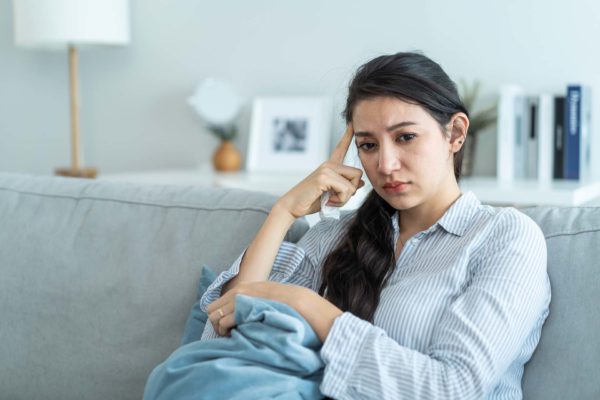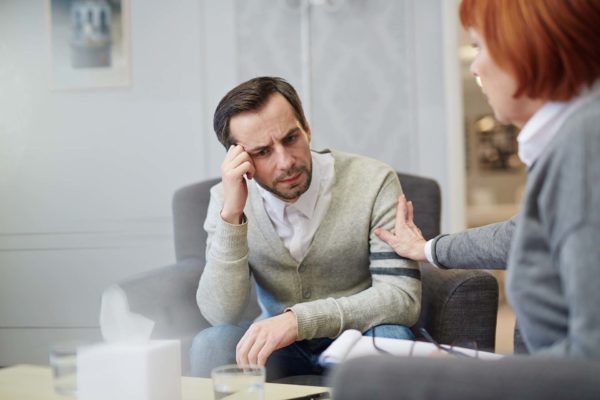Anxiety Definition
 Anxiety is the feeling of worry, panic or nervousness that occurs as a reaction to fear or stress, often over an impending event. However, anxiety becomes a problem when this reaction is out of proportion to the stress of a situation and starts to impact day to day life.
Anxiety is the feeling of worry, panic or nervousness that occurs as a reaction to fear or stress, often over an impending event. However, anxiety becomes a problem when this reaction is out of proportion to the stress of a situation and starts to impact day to day life.
Symptoms of anxiety disorders range from mild to severe with severe anxiety sufferers struggling with day-to-day living. Anxiety is a very common psychological disorder, affecting one in four people during their lives.
What Causes Anxiety?
Many factors contribute to the development of anxiety disorders including both genetic and environmental factors. The following have been shown to increase the risk of developing an anxiety disorder:
- Family history of anxiety and other psychiatric disorders;
- Female Sex;
- Childhood adversity;
- Chronic illness;
- Environmental stressors including trauma (physical or emotional), unemployment, and low socioeconomic status.
Anxiety Symptoms
Anxiety can affect the body in a number of ways and each person may experience anxiety very differently. Common symptoms of anxiety include:
- A sense of fear or dread;
- A feeling of being detached from or outside one’s body;
- Irritability;
- Poor concentration and ‘fogginess’ of thought;
- Sleep disturbance and fatigue;
- Muscle tension;
- Palpitations and/or chest pain;
- Shaking (tremor);
- Dry mouth;
- Headache;
- Nausea and diarrhoea

Anxiety Conditions
Common types of anxiety disorders
Generalised anxiety disorder
Generalised anxiety disorder (GAD) is characterised by frequent and uncontrollable worry over a combination of issues and situations. There are both physical and psychological symptoms associated with GAD and it affects the daily lives of those who suffer due to the frequency of the anxious thoughts.
Panic disorder
Panic disorder is an anxiety disorder which leads to frequent and unexpected surges of uncontrollable panic, often resulting in a panic attack. The feeling of panic often has no obvious cause or trigger and can occur at any given time. Those who suffer with panic disorder may also experience anxiety around having panic attacks themselves.
Social anxiety disorder
Social anxiety disorder is an uncontrollable fear of social settings. Also known as a social phobia, people who suffer with social anxiety disorder often experience extreme feelings of worry before, during and after a social event.
Phobias
A phobia is characterised by the feeling of an extreme sense of danger stemming from a situation or object. Phobias often lead to physical side effects including sweating and dizziness. People who suffer with phobias tend to take measures to avoid the situation or object the phobia stems from.
Agoraphobia
Agoraphobia is an extreme fear of settings which don’t have a clear and easily accessed escape route as well as settings where help isn’t readily available should it be needed. People who suffer with agoraphobia often avoid anxiety inducing settings as being in that situation may cause a panic attack.
Separation anxiety disorder
Separation anxiety disorder (SAD) is an extreme fear of being away from a person or attachment figure. This includes worrying about what could happen during separation as well as fear of events which may lead to the separation. Often triggered by experiences during childhood, SAD is most common in children but can also occur in adults.
Post-traumatic stress disorder
Post-traumatic stress disorder (PTSD) is an anxiety disorder stemming from distressing and traumatising past events or situations. People who suffer from PTSD often have graphic and frequent flashbacks to the event or situation, leading to a strong sense of distress.
What is the most common anxiety disorder in adults?
The most commonly diagnosed anxiety disorder in adults is generalised anxiety disorder (GAD).
How is Anxiety Diagnosed?
Anxiety is diagnosed from speaking to a patient to understand their symptoms in full, however other conditions may mimic anxiety and it is important to rule these out with further tests if suspected.
Questionnaires are a commonly used tool to aid making an anxiety diagnosis. They are also useful in monitoring response to treatment.
Anxiety Treatment
 Anxiety treatment options are dependent on which anxiety disorder(s) a person experiences and how severely they are affected.
Anxiety treatment options are dependent on which anxiety disorder(s) a person experiences and how severely they are affected.
Simple approaches; including exercise, relaxation techniques, improved sleep hygiene, identifying and removing stressors, and spending time with natural support groups (family and friends), can help manage anxiety symptoms and reduce the impact on quality of life.
Some patients will also benefit from an element of psychological therapy, including counselling, cognitive behavioural therapy (CBT), or exposure therapy.
Is there medication for anxiety?
Medication is often prescribed to people suffering with anxiety disorders. Medical management of anxiety primarily involves the use of anti-depressants (e.g. sertraline, fluoxetine) and benzodiazepines (e.g. diazepam). Beta-blockers (e.g. propranolol) can sometimes be useful for controlling symptoms experienced with panic attacks.
Anxiety and Medicinal Cannabis
Research into the effect of medicinal cannabis on anxiety is limited. However, following the legalisation of cannabis for medical purposes in 2018, there has been a rise in people looking towards medical cannabis. When first-line therapies have not proved effective at reducing symptoms, medical cannabis may be considered an option for anxiety.
For further information and to find out more about medical cannabis, click here to discover more about our award-winning Curaleaf Access Scheme. Alternatively, complete an eligibility assessment now. Once complete, one of our clinicians will review your application and advise whether you are eligible for progression to an appointment.

